Related Research Articles

The Mickey Mouse Club is an American variety television show that aired intermittently from 1955 to 1996 and returned to social media in 2017. Created by Walt Disney and produced by Walt Disney Productions, the program was first televised for four seasons, from 1955 to 1959, by ABC. This original run featured a regular, but ever-changing cast of mostly teen performers. ABC broadcast reruns weekday afternoons during the 1958–1959 season, airing right after American Bandstand. The show was revived three times after its initial 1955–1959 run on ABC, first from 1977 to 1979 for first-run syndication as The New Mickey Mouse Club, then from 1989 to 1996 as The All-New Mickey Mouse Club airing exclusively on cable television's The Disney Channel, and again in 2017 with the moniker Club Mickey Mouse airing exclusively on internet social media. It ended in 2018.

Kirk Douglas was an American actor and filmmaker. After an impoverished childhood, he made his film debut in The Strange Love of Martha Ivers (1946) with Barbara Stanwyck. Douglas soon developed into a leading box-office star throughout the 1950s, known for serious dramas, including westerns and war films. During his career, he appeared in more than 90 films and was known for his explosive acting style. He was named by the American Film Institute the 17th-greatest male star of Classic Hollywood cinema.
Animation in the United States in the television era was a period in the history of American animation that slowly set in with the decline of theatrical animated shorts and the popularization of television animation during the late 1950s to 1960s, peaked in the 1970s, and ended in the mid-late 1980s. This era is characterized by low budgets, limited animation, an emphasis on television over the theater, and the general perception of cartoons being primarily for children. Due to the perceived cheap production values, poor animation, and mixed critical and commercial reception, this era is sometimes referred to as the dark ageof American animation by critics.
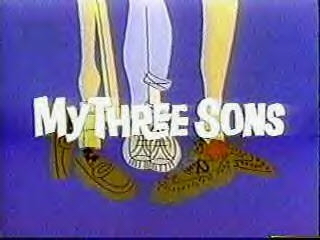
My Three Sons is an American television sitcom that aired from September 29, 1960, to April 13, 1972. The series was broadcast on ABC during its first five seasons, before moving to CBS for the remaining seasons. My Three Sons chronicles the life of widower and aeronautical engineer Steven Douglas as he raises his three sons.

Lassie is an American television series that follows the adventures of a female Rough Collie dog named Lassie and her companions, both human and animal. The show was the creation of producer Robert Maxwell and animal trainer Rudd Weatherwax and was televised from September 12, 1954, to March 25, 1973. The seventh longest-running U.S. primetime television series after The Simpsons, Law & Order: Special Victims Unit, Gunsmoke, Law & Order, Family Guy and NCIS, the show ran for 17 seasons on CBS before entering first-run syndication for its final two seasons. Initially filmed in black and white, the show transitioned to color in 1965.

Disney Television Animation (DTVA), formerly known as Walt Disney Pictures Television Animation Group and Walt Disney Television Animation, is the television animation production arm of Disney Branded Television, a sub-division of the Disney Entertainment division of The Walt Disney Company established on December 5, 1984, by Gary Krisel during the reorganization and subsequent re-incorporation of The Walt Disney Company following the arrival of then-Disney CEO Michael Eisner.

Screen Gems is an American brand name used by Sony Pictures Entertainment Motion Picture Group, a subsidiary of Japanese multinational conglomerate, Sony Group Corporation. It has served several different purposes for its parent companies over the decades since its incorporation, initially as a cartoon studio, then a television studio, and later on as a film studio. The label currently serves as a film production and distribution label that specializes in genre films, mainly horror.
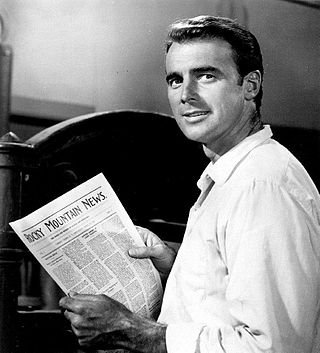
Jerome Courtland was an American actor, director and producer. He acted in films in the 1940s, 1950s and 1960s, and in television in the 1950s and 1960s. Courtland also appeared on Broadway in the musical Flahooley in the early 1950s. He directed and produced television series in the 1960s, 1970s and 1980s. He served in the Pacific Theater of World War II.
Ziv Television Programs, Inc. was an American production company that specialized in productions for first-run television syndication in the 1950s.

An anthology series is a radio, television, video game or film series that spans different genres and presents a different story and a different set of characters in each different episode, season, segment, or short. These usually have a different cast in each episode, but several series in the past, such as Four Star Playhouse, employed a permanent troupe of character actors who would appear in a different drama each week. Some anthology series, such as Studio One, began on radio and then expanded to television.

Walter Lee Barnes was an American football guard and actor who played in National Football League (NFL) for four seasons. He played in the (NFL) for the Philadelphia Eagles and in college at Louisiana State University. Barnes was an actor in both American and European films. He appeared in several films with John Wayne, Lex Barker, and Clint Eastwood.
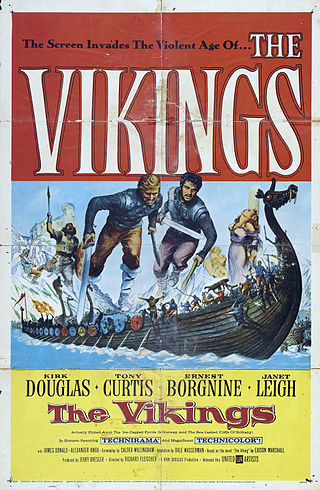
The Vikings is a 1958 American epic historical fiction swashbuckling film directed by Richard Fleischer and filmed in Technicolor. It was produced by Jerry Bresler and stars Kirk Douglas. It is based on the 1951 novel The Viking by Edison Marshall, which in turn is based on material from the sagas of Ragnar Lodbrok and his sons. Other starring roles were taken by then husband-and-wife Tony Curtis and Janet Leigh as well as Ernest Borgnine. The film made notable use of natural locations in Norway. It was mostly filmed in Maurangerfjorden and Maurangsnes, captured on film by cinematographer Jack Cardiff, although Aella's castle was the real Fort-la-Latte in north-east Brittany in France.
Charles William Fries was an American film and television producer who worked on many TV series, made-for-TV movies, and theatrical films.

John Rollin Lupton was an American film and television actor.
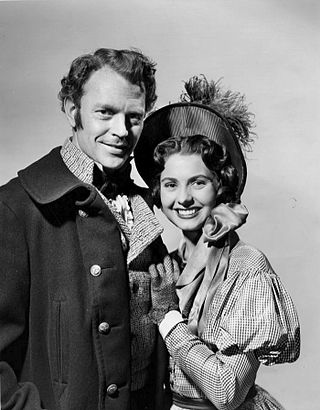
Schlitz Playhouse of Stars is an anthology series that was telecast from 1951 until 1959 on CBS. Offering both comedies and drama, the series was sponsored by the Joseph Schlitz Brewing Company. The title was shortened to Schlitz Playhouse beginning with the fall 1957 season.
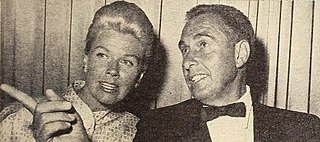
Martin Melcher was an American motion picture and music executive. He was married to popular singer and actress Doris Day, with whom he owned a series of business ventures named Arwin. Melcher produced several films in the 1950s and 1960s through the independent film production company Arwin Productions, released music through the record label Arwin Records, and published music through the music publishing companies Arwin Music and Daywin Music, Mart Music and Artists Music. He also was the president of Kirk Douglas' music publishing company, Peter Vincent Music.

Ichabod and Me is an American situation comedy television series starring Robert Sterling and George Chandler that aired in the United States during the 1961–1962 television season. It depicts the life of a New York City newspaper reporter who moves to a small New England town and becomes the publisher of its newspaper.
John D. Craig (1903–1997) was an American businessman, writer, soldier, diver, Hollywood stunt man, film producer, and television host. He worked in the commercial surface-supplied diving industry from the 1930s on, and filmed aerial combat over Europe during World War II. He is best known for using film and television to show the United States public the beauties and dangers of Earth's underwater worlds.

Bryna Productions is an American independent film and television production company established by actor Kirk Douglas in 1949. The company also produced a handful of films through its subsidiaries, Michael Productions, Joel Productions and Douglas and Lewis Productions, and outside the United States through Brynaprod. Other subsidiaries included Eric Productions, which produced stage plays, Peter Vincent Music, a music publishing company, Bryna International, a photographic service company, and Public Relations Consultants, which supervised the publicity of its early films. Douglas named the main company after his mother, Bryna Demsky, while its primary subsidiaries were named after his sons: Michael Douglas, Joel Douglas, Peter Douglas and Eric Douglas. In 1970, Bryna Productions was renamed The Bryna Company, when Douglas welcomed his children and second wife into the firm. Nevertheless, Michael, Joel and Peter, wanting to establish individual identities, went on to form their own independent film production companies.

The Wisconsin Center for Film and Theater Research (WCFTR) is a major archive of motion picture, television, radio, and theater research materials. Located in the headquarters building of the Wisconsin Historical Society in Madison, Wisconsin, the WCFTR holds over three hundred collections from motion picture, television, and theater writers, producers, actors, designers, directors, and production companies. These collections include business records, personal papers, scripts, photographs, promotional graphics, and some twenty thousand films and videotapes of motion picture and television productions.
References
- ↑ "Kirk Douglas's work in American Theater, Radio, and Television", Wisconsin Center for Film and Theater Research, University of Wisconsin - Madison
- ↑ "Remembering Jerome Courtland", The Walt Disney Family Museum
- ↑ Freese, Gene Scott. Hollywood Stunt Performers, 1910s-1970s, McFarland, 2014 ISBN 9781476614700